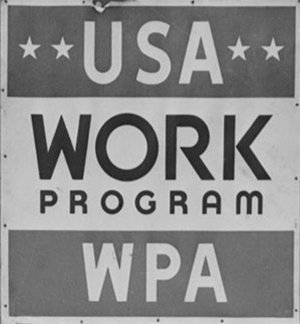
About the WPA and the WPA Oral Histories Collection
The Works Progress Administration (WPA), created on May 6, 1935 by an executive order from President Franklin D. Roosevelt, was part of Roosevelt’s New Deal. This series of programs, projects, and actions by Roosevelt and Congress aimed to end the economic depression in the 1930s by reforming America’s financial infrastructure and providing employment for millions of unemployed Americans. While much of WPA dealt with constructing public buildings, roads, bridges, dams, and other infrastructure items, other programs of the WPA addressed performing and visual arts projects. Federal Project Number One or simply “Federal One”, comprised the Federal Art, Federal Writers, Federal Music and Federal Theatre Projects. Together, these projects not only employed artists, writers, musicians, and actors to work in their chosen fields. They also introduced the arts to a wide swath of America which had not been previously exposed.
The Federal Theatre Project (FTP), directed by Hallie Flanagan, hired several thousand actors, directors, playwrights, producers and others in the entertainment industry during the Great Depression. During its four-year lifespan FTP featured the early works of future notable artists such as Orson Welles, Arthur Miller, and Elia Kazan. In 1939 the program was discontinued by the Federal Government due to accusations by opponents of wasteful spending and alleged promotion of Left-wing propaganda.
George Mason University’s association with the WPA records began in the summer of 1973 when Mason faculty members Lorraine Brown and John O’Connor discovered a cache of FTP materials in a government-owned airplane hangar near Baltimore, Maryland. The university struck a deal with the Library of Congress, the custodian of the records at that time, and the materials were placed on loan to George Mason for processing and access.
Beginning in 1974 Professors Brown and O’Connor created and ran the Research Center for the Study of the Federal Theatre Project to organize the materials, preserve the collection in archival folders and boxes, provide descriptive information, and promote research accessibility. While the Center’s focus was primarily the nearly 700 linear feet of original archival materials, staff also identified and cultivated gifts of complementary collections and materials related to the FTP and WPA, including donations of personal papers and other items from, as well as a series of oral history interviews of, former employees of the FTP. In the early 1980s the Center was renamed the Institute for the Study of Government Society and the Arts, reflecting its interest in collecting and disseminating materials and oral histories pertaining to the other WPA Federal One projects. The materials remained at Mason until August of 1994, when they were recalled by the Library of Congress. Information about, and contents of, the Library of Congress collection may be found here: Library of Congress
Arguably, the most valuable of the WPA-related records at George Mason University are these oral history interviews conducted with nearly three hundred employees and administrators of the FTP and other WPA projects. Originally recorded on open-reel and compact cassette tapes in the 1970s and 1980s, they have now been digitized to both preserve the originals and make the stories more available. These interviews include the voices of the relatives, students, and assistants of Hallie Flanigan, Director of the Federal Theatre Project; the voice of Carlton Moss, one of the first black directors of the New York Negro Unit; the voice of Shirley Graham, director of the Chicago Negro Unit (and later wife of W.E.B. DuBois); the voice of Arnold Weissberger, the attorney who represented Orson Welles and John Houseman; and many others. The collection is also notable for its inclusion of voices traditionally underrepresented in the early 20th century, such as women (about 25% of the collection) and African Americans.
Broader access and exposure to these voices will hopefully enhance scholarship and understanding of the 1930s and America today. Such access creates an additional window of insight into WPA projects, the people who were employed by them, and the people who lived during this time period - expanding our understanding of the WPA and the cultural and historical moment in which it existed.
This project was made possible by a grant from the Council on Library and Information Resources (CLIR) to preserve recordings at risk.



